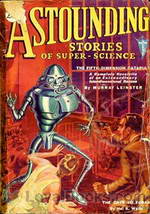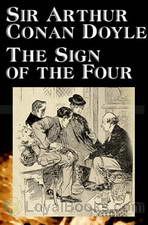|
Books Should Be Free Loyal Books Free Public Domain Audiobooks & eBook Downloads |
|
|
Books Should Be Free Loyal Books Free Public Domain Audiobooks & eBook Downloads |
|
Adventure Books |
|---|
|
Book type:
Sort by:
View by:
|
By: Rudyard Kipling (1865-1936) | |
|---|---|
 The Man Who Would Be King
The Man Who Would Be King
The Man Who Would Be King tells the story of two British adventurers in British India who become kings of Kafiristan, a remote part of Afghanistan. It was inspired by the exploits of James Brooke, an Englishman who became the “white Raja” of Sarawak in Borneo, and by the travels of American adventurer Josiah Harlan, who claimed the title Prince of Ghor. The story was first published in The Phantom Rickshaw and other Tales (Volume Five of the Indian Railway Library, published by A H Wheeler & Co of Allahabad in 1888)... | |
 Puck of Pook's Hill
Puck of Pook's Hill
Puck of Pook’s Hill is a children’s book by Rudyard Kipling, published in 1906, containing a series of short stories set in different periods of history. The stories are all told to two children living near Pevensey by people magically plucked out of history by Puck. | |
 The Brushwood Boy
The Brushwood Boy
The experiences in public school, Sandhurst and military life in India of Major George Cottar together with his adventures in the dream world he discovers and frequents. | |
By: Russell Thorndike (1885-1972) | |
|---|---|
 Doctor Syn
Doctor Syn
Doctor Syn: A Tale of the Romney Marsh is the first in the series of Doctor Syn novels by Russell Thorndike and inspired a Disney movie called the Scarecrow of Romney Marsh starring Patrick Patrick McGoohan. In this story we are introduced to the complex Christopher Syn, the kindly vicar of the little town of Dymchurch. Dr Syn seems pleasant, but is he much more than he seems? Although published first, this book is the last of the series chronologically. The town is located near the Romney Marsh, an ideal location for smuggling operations... | |
By: Ruth Plumly Thompson (1891-1976) | |
|---|---|
 The Royal Book of Oz
The Royal Book of Oz
The Royal Book of Oz (1921) is the fifteenth in the series of Oz books, and the first to be written by Ruth Plumly Thompson after L. Frank Baum’s death. Although Baum was credited as the author, it was written entirely by Thompson. The Scarecrow is upset when Professor Wogglebug tells him that he has no family, so he goes to where Dorothy Gale found him to trace his “roots.” Then he vanishes from the face of Oz. Dorothy and the Cowardly Lion mount a search for their friend, but when that is successful, they will need to become a rescue party! | |
By: S. R. Crockett (1859-1914) | |
|---|---|
 Grey Man
Grey Man
This novel is set in Scotland in turbulent times, and we are immediately introduced to intrigue and family strife. At Launcelot Kennedy's aunt's husband's funeral, he and his father are first hidden, then hustled away secretly for fear of being spies. Werewolves, murder, secret trysts, vengeance and siege are the backdrop to this tale as Kennedy is set against Kennedy in this chilling feud. | |
By: Samuel B. Allison | |
|---|---|
 An American Robinson Crusoe
An American Robinson Crusoe
An American Robinson Crusoe is a short version of the original story. An indolent, rebellious teen goes on a marine voyage against his parents’ wishes. The ship (and all of its crew) is lost in a storm, but Robinson makes it to a deserted island. He has no tools, no weapons, but he lives for over 28 years on the island. He befriends many animals on the island and after over 20 years living solo, he is joined by a young “savage” who becomes his constant companion. The transformation from the young, lazy teen to a self-sustaining, incredibly knowledgeable adult is one of the major themes in the story. | |
By: Samuel Johnson (1709-1784) | |
|---|---|
 Rasselas, Prince of Abyssinia
Rasselas, Prince of Abyssinia
In this enchanting fable (subtitled The Choice of Life), Rasselas and his retinue burrow their way out of the totalitarian paradise of the Happy Valley in search of that triad of eighteenth-century aspiration – life, liberty and happiness.According to that quirky authority, James Boswell, Johnson penned his only work of prose fiction in a handful of days to cover the cost of his mother’s funeral. The stylistic elegance of the book and its wide-ranging philosophical concerns give no hint of haste or superficiality... | |
By: Samuel Merwin | |
|---|---|
 Calumet "K"
Calumet "K"
"A novel, with several elements of rather unusual interest. As a tale, it is swift, simple, and absorbing, and one does not willingly put it down until it is finished. It has to do with grain-elevator business, with railways, strikes, and commercial and financial matters generally, woven skilfully into a human story of love." --The Commercial Advertiser "'Calumet "K"' is a novel that is exciting and absorbing, but not the least bit sensational. It is the story of a rush.... The book is an unusually good story; one that shows the inner workings of the labor union, and portrays men who are the bone and sinew of the earth... | |
 The Merry Anne
The Merry Anne
This 1904 maritime adventure is set in the Great Lakes region, upon water and in wood. Our hero is caught in a smuggling scheme and may lose his boat and his sweetheart. With a fast pace and interesting plot, the story is made realistic with very modern "bad-guys". | |
By: Sapper (Herman Cyril McNeile) (1888-1937) | |
|---|---|
 Bulldog Drummond
Bulldog Drummond
‘Sapper’, the pseudonym of Colonel. H.C. McNeile M.C. was one of the most popular English writers of thrillers between the two world wars. And Hugh (Bulldog) Drummond was his most popular leading character. This book, the first of the series, is of its time. Opinions are expressed which would not pass muster today and the books are strongly laced with jingoism, racial stereotypes and hostile references to foreigners. Naturally all the villains are masters of disguise and invariably put off murdering the hero until later whist they think of something absolutely beastly. Nevertheless the story is a good one and well told. | |
By: Sax Rohmer (1883-1959) | |
|---|---|
 The Return of Dr. Fu-Manchu
The Return of Dr. Fu-Manchu
Burmese Commisioner Nayland Smith and his faithful friend Dr Petrie continue their fight against the evil genius of Dr Fu-Manchu when they seek to save the good doctor’s lost love and protect the British Empire from disaster when their malignant enemy returns to England. | |
 The Hand of Fu-Manchu
The Hand of Fu-Manchu
Further adventures of Nayland Smith and Doctor Petrie as they continue their battles against the evil genius, Dr Fu-Manchu. | |
 The Insidious Dr. Fu-Manchu
The Insidious Dr. Fu-Manchu
The first of the Fu-Manchu novels this story follows the two characters who are set against the machinations of the insidious doctor. | |
 The Quest of the Sacred Slipper
The Quest of the Sacred Slipper
Cavanagh becomes involved in the adventurous search for a precious relic in the mysterious East. (Introduction by Laineyben) | |
By: Seckatary Hawkins (1890-1972) | |
|---|---|
 Red Runners
Red Runners
This Is one of the Hawkins series and a right good one at that! Big boys and little boys, manly and "yellow", all these figure in the adventures which are recounted and the reader is quite breathless by the time he has taken part even vicariously in the numerous pranks and serious experiences. Good wholesome lessons are taught also as when the bully of the group comes to realize some of the big things of life just before he is called to the larger life beyond this one A real boys book but girls will like It also... | |
 Seckatary Hawkins in Cuba
Seckatary Hawkins in Cuba
Seckatary Hawkins, the genial fat boy, is a favorite character with everyone who enjoys the deeds of a very real boy who manages to discover that adventure and mystery are not so very far off for one who looks for them. In Seckatary Hawkins in Cuba, he is embarked on that greatest of adventures, the search for hidden treasure. It is the hoard of old Cazanova in Cuba upon the quest for which young Hawkins is intent, and there are thrills and surprises and laughs aplenty in his narrative of the events encountered... | |
 Knights of the Square Table
Knights of the Square Table
Here is a mystery story for boys of all ages - from nine to ninety. It is a typical Seckatary Hawkins tale, told by the young scribe who takes care of all the troubles and mysteries that assail him and his young friends in their old clubhouse on the river bank. Your boy - and your girl, too, for that matter - will fairly revel in this book, and many will read it over and over again. It teems with the adventure of boyhood, and while it furnishes and abundance of thrills, it does so in a manner that is bound to teach the young reader the importance of thinking for himself and of playing fair and square throughout his lifetime... | |
By: Sewell Peaslee Wright (1897-1970) | |
|---|---|
 Astounding Stories 13, January 1931
Astounding Stories 13, January 1931
This issue contains "The Dark Side of Antri" by Sewell Peaslea Wright, "The Sunken Empire" by H. Thompson Rich, "The Gate to Xoran" by Hal K. Wells, "The Eye of Allah" by C. D. Willard, "The Fifth-Dimension Catapult" by Murray Leinster, and "The Pirate Planet[' by Charles W. Diffin. | |
By: Seymour Eaton (1859-1916) | |
|---|---|
 Roosevelt Bears
Roosevelt Bears
"The Roosevelt Bears - Their Travels and Adventures" is full of fun as we follow the journeys and mishaps of two big, delightful bears. Tired of life in the West of America and eager to see places of which they had only heard, Teddy-B and Teddy-G head east. All ages will laugh and enjoy the antics told in lively rhyme - whether riding a train, donkey, balloon or boat, running a farm, attending school, or ... sitting in jail. - Summary by HannahMary | |
 More About the Roosevelt Bears
More About the Roosevelt Bears
An entertaining sequel to the beloved Roosevelt Bears - Their Travels and Adventures. The Bears are once again full of hijinks and merriment as they make their way down the Eastern half of the United States. Enjoying baseball, publishing a newspaper, visiting the zoo and playing firemen Teddy-B and Teddy-G entertain the children and cause chaos for the city leaders. Book one in the series can be found here. Book three in the series can be found here. | |
By: Sidford Frederick Hamp (1855-1919) | |
|---|---|
 Coco Bolo: King of the Floating Island
Coco Bolo: King of the Floating Island
Sisters Margaret and Frances wait for their younger brother Edward to go for a nap before embarking on the adventure of trying to stand on the heads of their shadows. Daddy sees them and encourages them to chase further adventures of childhood, little suspecting where they will take them. - Summary by Lynne Thompson | |
By: Sinclair Lewis (1885-1951) | |
|---|---|
 Free Air
Free Air
This road trip novel is set in the early twentieth century and follows the experiences of an aristocratic New Englander and her father as they travel by automobile from Minneapolis to Seattle. She is wooed and won by a noble but simple commoner she meets along the way. Lewis is at his usual wryly humorous self, poking fun at the upper class and treating the common people only slightly better. | |
By: Sir Arthur Conan Doyle (1859-1930) | |
|---|---|
 The Return of Sherlock Holmes
The Return of Sherlock Holmes
A young gambler is found shot dead in a closed room. Dr. Watson, who still mourns the disappearance of his famous friend is intrigued enough to step out of his house and take a look at the crime scene. A crowd has gathered there, curiously gazing up at the room where the crime is supposed to have taken place. Watson inadvertently jostles against an elderly, deformed man and knocks a stack of books from the fellow's hand. The man curses Watson vilely and disappears into the throng. It suddenly occurs to Watson that one of the books that he had helped the stranger pick up had seemed familiar... | |
 The Memoirs of Sherlock Holmes
The Memoirs of Sherlock Holmes
For more than a century and a quarter, fans of detective fiction have enjoyed the doings of the iconic sleuth, Mr. Sherlock Holmes. In the company of his faithful companion, Dr Watson, Holmes has consistently delighted generations of readers. Created by a Scottish writer and physician, Sir Arthur Conan Doyle, this immortal private eye has solved cases for kings and commoners, lovely damsels and little old ladies, engineers and country squires and a legion of others who come to him in distress and perplexity... | |
 The Sign of the Four
The Sign of the Four
A secret shared by four convicts and two prison guards, a daughter in search of her missing father, a strange gift of a single pearl received every year, a fabulous treasure buried in the ancient Agra Fort in India, an eccentric detective being consulted to solve a deadly puzzle. All these events are set against the turbulent backdrop of the Great Indian Mutiny of 1857 in the second Sherlock Holmes novel by Sir Arthur Conan Doyle, The Sign of the Four. Mary Morstan, a lovely young woman, comes to the Baker Street lodgings shared by Holmes and Dr Watson... | |
 His Last Bow
His Last Bow
The disappearance of a German spy and the gathering storm that foretells the prelude to World War I is what greets you in this riveting book. The further you read the more mysteries unfold like secret submarine plans with some pages missing found in the hands of a corpse. There's also family insanity in Cornwall, a dead Spaniard and mafia hiding in an empty London flat. His Last Bow was published in the Strand Magazine circa 1908 and included several other short stories as well. Even during Sir Arthur Conan Doyle's own lifetime, Holmes had acquired cult status... | |
 The Valley of Fear
The Valley of Fear
Doyle's final novel featuring the beloved sleuth, Sherlock Holmes, brings the detective and his friend to a country manor where they are preceded by either a murder or a suicide. A secretive organization lies culprit and an infiltration of it is in order. | |
 The Adventures of Gerard
The Adventures of Gerard
These lesser known stories were penned by Conan Doyle during the period between killing off Sherlock Holmes in 1893 and reluctantly resurrecting him some ten years later. The swashbuckling, eponymous hero, Etienne Gerard, is one of Napoleon's gallant French Hussars, who considers himself the finest of them all. Through these "Boys Own Adventures", Conan Doyle pokes gentle fun at both the French and the English. This is the second volume containing eight adventures. | |
 The Poison Belt
The Poison Belt
Three years after the events that took place in The Lost World, Professor Challenger urgently summons his fellow explorers (Professor Summerlee, Lord John Roxton, and reporter E.D. Malone) to a meeting. Oddly, he requires each to bring an oxygen cylinder with him. What he soon informs them is that from astronomical data and just-received telegraphs of strange accidents on the other side of the world, he has deduced that the Earth is starting to move through a region of space containing something poisonous to humankind... | |
 The White Company
The White Company
Set during the Hundred Years’ War with France, The White Company tells the story of a young Saxon man who is learning what it is to be a knight. Raised by Cistercian Monks and rejected by a violent elder brother, Alleyn Edricson takes service with one of the foremost knights in the country. When Alleyn falls in love with the knight’s daughter, he must prove himself to be a courageous and honourable knight before he can win her hand. Alleyn and his friends set forth with the other men-at-arms to join Prince Edward in Bordeaux, from where they will take part in the Prince’s campaign into Spain... | |
 The Tragedy of the Korosko
The Tragedy of the Korosko
| |